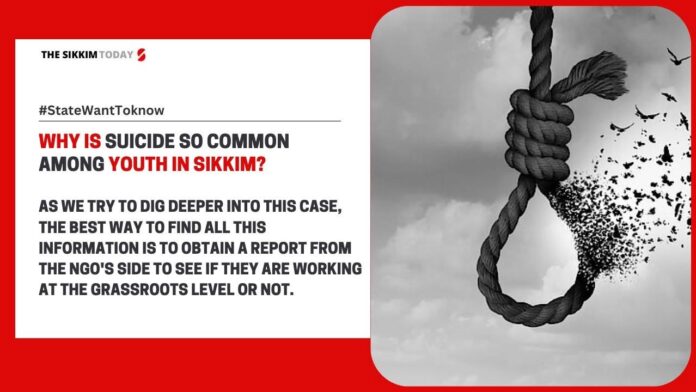Three cases of suicide were reported last months in Sikkim, and another three cases were reported last week. According to 2024 data, Sikkim has a high suicide rate of 43.1 per 100,000 population, whereas the national average is 12.4%, which is alarming.
Sikkim, with a population of six-seven lakh, faces significant economic and financial issues, which can be major factors in these incidents, particularly among those aged 17-40 years. Unfortunately, most cases remain unexplored. Why are they doing it? Until now, no detailed study has been conducted.
Upon studying data from 2020 to 2022, there were 266 suicide attempts in Sikkim, with the East district and adjoining areas contributing to a 39.2% suicide rate among States and Union Territories in 2021. The majority of those who committed suicide were between 17-40 years old—a productive age group.
But why does the 17-40 age group take this step? It remains a mystery. Perhaps it indicates a rise in stress, mental disorders, changing lifestyles, financial crises, or even digital scams, such as losing money to fraudsters. In Siliguri, West Bengal, there was a report of a young man who took a loan from an online app. Unable to repay it and facing harassment, he took his own life.
Another factor leading to suicides in Sikkim is multifaceted, including poverty, lack of access to necessities, and an overwhelming sense of hopelessness. Economic development and industrialization must not exacerbate despair or suicidal ideation.
People living hand-to-mouth are losing hope in their lives, particularly due to failures in life or lack of financial support. By valuing diversity and promoting equality, we can create a society where everyone feels valued and can contribute to building a future where humanity may once again thrive in Sikkim. However, internally, it is a serious concern.
To combat this crisis, we must address the root causes and provide support to vulnerable communities. But we should also acknowledge that communities do not always extend a helping hand during difficult times, making people lose faith in them. This includes expanding access to mental health services, tackling discrimination and unemployment, and raising awareness about suicide prevention. Poor communities often have limited access to mental health resources, social support, and crisis intervention, making them particularly vulnerable.
Public and private partnerships should be promoted to design social safety nets and work collaboratively for the well-being of these communities. Civil society must champion the richness of Sikkim’s culture and environment rather than constantly focusing on the economic crisis, which creates dreams without a level playing field.
Sikkim’s high suicide rate of 43.1 per 100,000 population is especially concerning when compared to the national average of 12.4%, according to sources.
Now, a simple question arises: What are NGOs in Sikkim doing to combat this? When we question them, they say they lack resources to support people. Resources mean collaboration, sourcing solutions, and working at the ground level to understand the root causes. Not everything is about mental health. Not everything is about depression. Not everything is about unemployment. With just a 6-7 lakh population and a lack of study and action by NGOs, we will still question them sooner or later in an open forum. Despite Sikkim’s population decreasing, the state still ranks among the highest in suicide rates.
Another issue is the hanging banners by the roadside with helpline numbers that often don’t work. That isn’t enough. The state needs dedicated experts who can study and address the issue and implement effective solutions. Currently, no substantial study has been undertaken to understand the scope of the problem.
Does putting up banners or Speaking on stage by NGO help prevent suicides? Or does the state need serious attention and expert intervention to address this crisis? Should we continue to ignore it and let it be, or take meaningful action?The richness of Sikkim’s culture and environment must be promoted in open spaces, and the economic well-being of a few should not come at the cost of human lives. It simply isn’t worth it—or is it?





